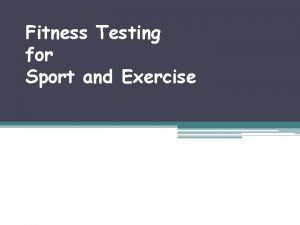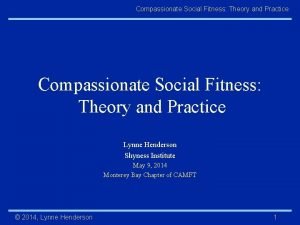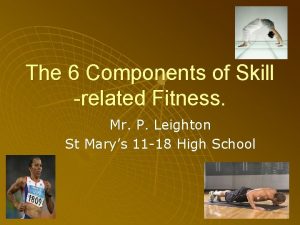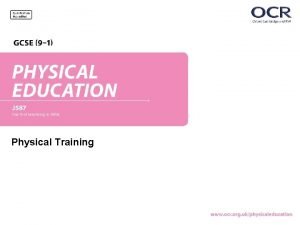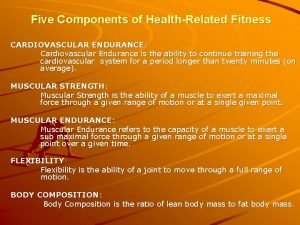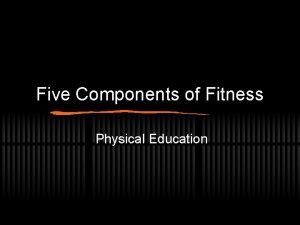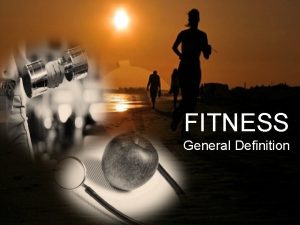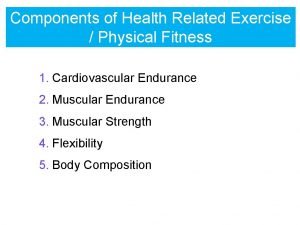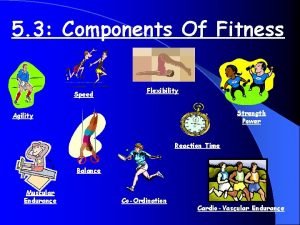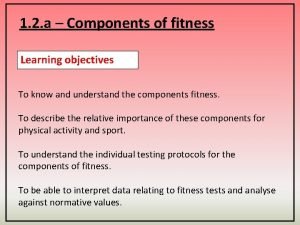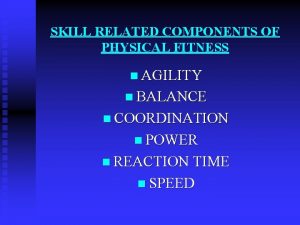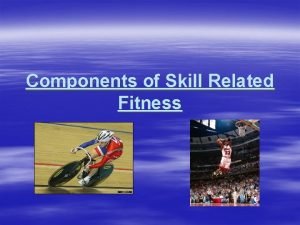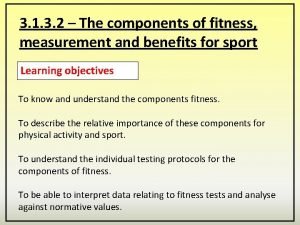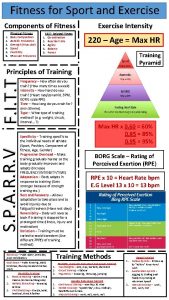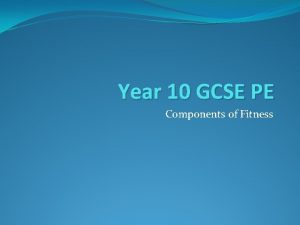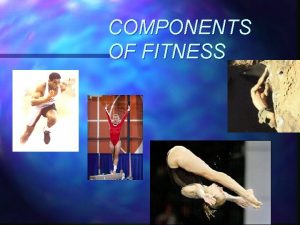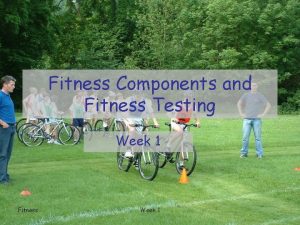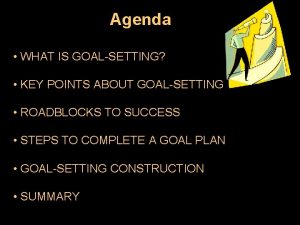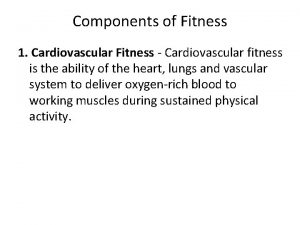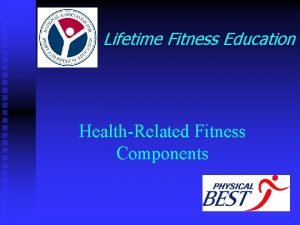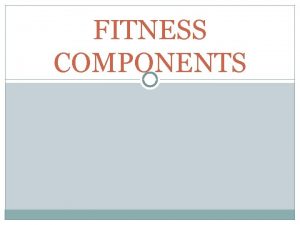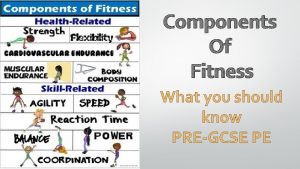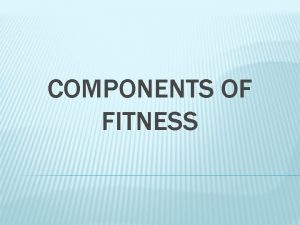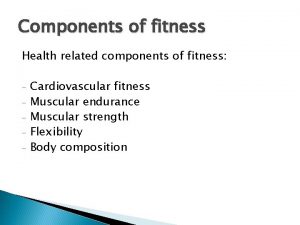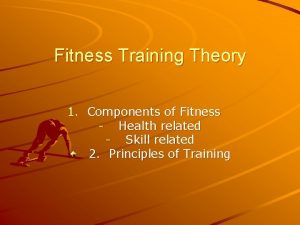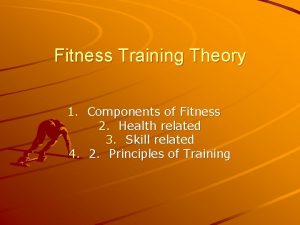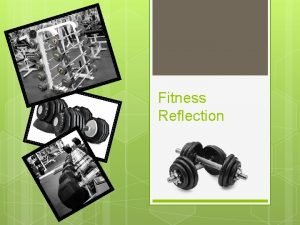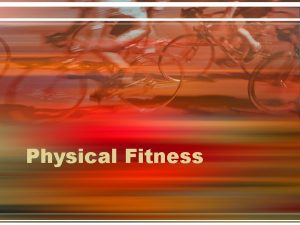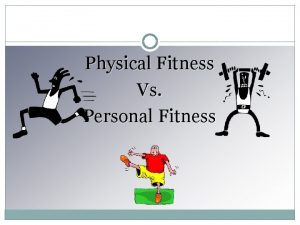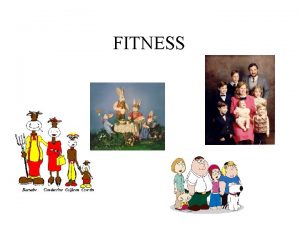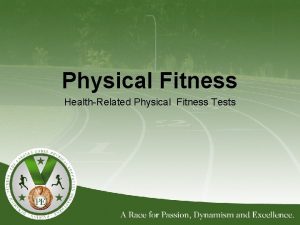FITNESS THEORY Components of Testing Goalsetting and the























- Slides: 23

FITNESS THEORY Components of Testing, Goal-setting and the FITT Formula

HEALTH RELATED COMPONENTS OF FITNESS

CARDIOVASCULAR ENDURANCE • improves the heart, circulatory and respiratory systems – Makes your heart more efficient – Improves heart’s ability to bring oxygen to muscles – Improves muscles’ ability to use oxygen – It is AEROBIC exercise (using oxygen) – The most important component to indicate fitness § BRAINSTORM EXAMPLES

Examples of Cardiovascular Endurance training exercises • Jogging, swimming, rollerblading, aerobic classes, cardio-type dance (Zumba), speed walking, cycling

MUSCULAR ENDURANCE • is the ability to perform an activity for a long period of time, either in repeated repetitions or to hold a position for a length of time – Produces “burn” in muscles – Builds long, lean muscles, muscle tone – ANAEROBIC exercise (without oxygen) • BRAINSTORM EXAMPLES

Examples of Muscular Endurance training exercises - Weight lifting: high repetitions, low weight – (3 sets of 15 -20 repetitions) – Body resistance exercises (curl-ups, push ups, crunches, squats, lunges, plank, all core exercises) • Ie. 3 sets of 30 crunches, 3 sets of 10 pushups, etc.

MUSCULAR STRENGTH • the amount of energy a muscle can produce usually in one repetition. – – Short, powerful workouts builds big, bulky muscles ANAEROBIC exercise (without oxygen) BRAINSTORM EXAMPLES

Examples of Muscular Strength training • Weight lifting: heavy weight, low repetitions • Intervals of powerful, short-duration movements: – Jumping, sprinting, throwing, striking activities

FLEXIBILITY • ability to move a joint through its full range of motion. – How far can you stretch?

Examples of Flexibility training exercises Dynamic stretching: pre-activity – Stretching by moving through range of motion • Knees up, bum-kicks, squats, “A’s” and “B’s” Static Stretching: post-activity -being still while stretching and holding stretch for extended period of time ie. 3 sets of 30 seconds • quad stretch, triceps’ stretch, calf stretch

BODY COMPOSITION • is body mass, percent body fat, lean muscle mass and body type. – Your body type will not change but you can make any body look good by getting FIT!

FITT FORMULA Frequency, Intensity, Time, Type -a formula to show me how I can train in order to improve any Component of Fitness

FREQUENCY • Refers to the number of training sessions done in one week

INTENSITY • Refers to how hard the individual must work during a training session • Measured using your heart rate (beats per minute/ bpm) – Take pulse to measure heart rate • Take pulse for 10 sec and multiply by 6 to get bpm

TIME • The amount of time spent in each single training session: – Ie. “today I will run for 25 minutes”

TYPE • The specific kind of exercise that will be done • There will be more than one type of exercise that can be done to improve performance in each component of fitness – Each exercise must be related to the end goal though • ie. Doing situps will not improve your pushup scores


GOAL SETTING (SMART formula) MY GOALS In order to set a goal for yourself (in this case, a fitness goal), it should meet the following criteria:

SPECIFIC • What is the specific component of fitness and specific fitness test that you are working to improve?

MEASURABLE (give it a number) • Provide a specific number for your goal • For example: 20 push ups 7 laps 8 minutes

A ATTAINABLE (is it possible? ) • Will you be able to achieve this goal? • How will you achieve it?

R REALISTIC (is it probable? ) • Is this a realistic goal for you? • Is it within your fitness capabilities? • Why do you think so?

T TIME FRAME (when will it be complete? ) • Set a date by which you will have achieved your goal. • For our purposes, it will be by the next round of fitness testing Fall Winter Spring
 Skill related fitness vs health related fitness
Skill related fitness vs health related fitness Components of physical fitness grade 7
Components of physical fitness grade 7 Physical fitness test grade 9
Physical fitness test grade 9 Fitness testing for sport and exercise
Fitness testing for sport and exercise Social fitness training
Social fitness training 6 components of skill related fitness
6 components of skill related fitness 2 components of fitness
2 components of fitness Speed and agility frequency, intensity, time type
Speed and agility frequency, intensity, time type Cardiovascular endurance health related fitness
Cardiovascular endurance health related fitness Five components of fitness
Five components of fitness Components of fitness definition
Components of fitness definition Five components of health related fitness
Five components of health related fitness Components of fitness
Components of fitness Hexagon agility test average clockwise and counterclockwise
Hexagon agility test average clockwise and counterclockwise Strength speed agility endurance flexibility
Strength speed agility endurance flexibility Agility test exercise
Agility test exercise What is agility in physical education
What is agility in physical education Flexed arm hang test chart
Flexed arm hang test chart Agility in skill related fitness
Agility in skill related fitness Physical fitness is of two types
Physical fitness is of two types Ruler drop test normative data
Ruler drop test normative data Components of fitness btec sport
Components of fitness btec sport Skill related fitness
Skill related fitness Physical education quiz
Physical education quiz



